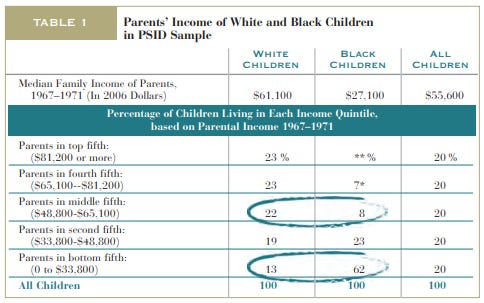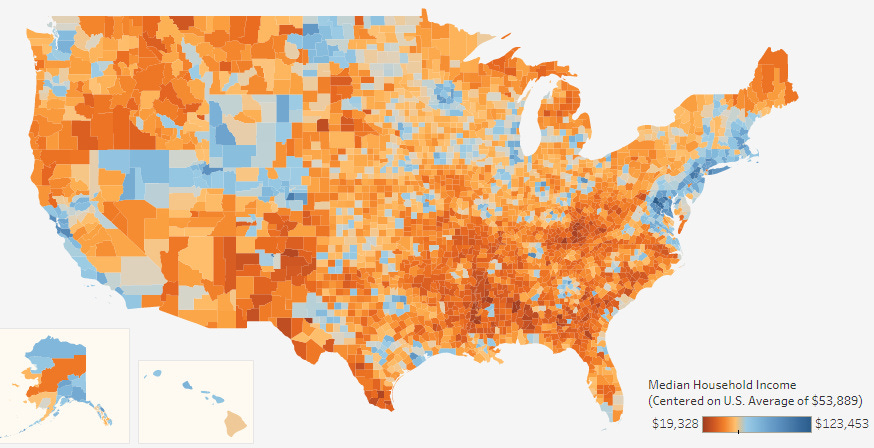In my first post, I clarified the difference between absolute and relative intergenerational mobility and dove into the current data to characterize it’s state compared to our past and our peer nations.
For a quick review, absolute IGM is a comparison of the real incomes of children to their parents to see who earns more. This has always been very strong in America, and despite some slowdowns or reversals in the latter half of the 20th century, absolute IGM is still very strong in the US: “Ninety-three percent of Americans whose parents were in the bottom fifth of the income ladder and 88 percent of those whose parents were in the middle quintile exceed their parents’ family income as adults.”
Relative IGM compares the position of parents in the income percentile distribution to that of their kids. Rather than measuring the mobility in standard of living, relative IGM measures mobility in social status. It is low if children born in the bottom 20% today stay in the bottom 20% even if the bottom 20% becomes 10x richer. This figure has remained remarkably stable over time. Compared to peer nations, our relative IGM is lower, but this difference is concentrated within the bottom quintile of our income distribution; the mobility in and out of the top 4 quintiles is basically the same across all the surveyed nations.
What does this data tell us about the potential causes and solutions for low IGM in the United States?
Who is lagging behind?
In the US, the rich don’t stay rich anymore than they do in other developed nations; a fool is quickly parted with his money. The middle income quintiles are also close to the levels in other nations and are very mobile. But more of the poor stay poor in the US than any of the other nations in the list. The US matches the relative mobility statistics of very egalitarian nations in all but the very bottom of the distribution. This indicates that movement between the top 4 income quintiles in the US is meritocratic, or it’s at least as meritocratic as it is in Denmark or Sweden. However, movement in and out of the bottom quintile is clearly skewed and biased compared to these nations.
This dynamic would only be possible if there was a group of Americans who are disproportionately likely to be poor and stay poor even when they have the skills required to advance up the status ladder. This group would be overrepresented in the bottom quintile and have their merit systematically less likely to be noticed and rewarded by society. Unfortunately, American Blacks fit this description all too well.
African Americans fare worse on all metrics of absolute and relative mobility in the us.
“Blacks have a harder time exceeding the family income and wealth of their parents than do whites. Sixty-six percent of blacks raised in the second quintile surpass their parents’ family income compared with 89 percent of whites. Only 23 percent of blacks raised in the middle surpass their parents’ family wealth compared with over half (56 percent) of whites.”
“Blacks are more likely to be stuck in the bottom and fall from the middle than are whites. Over half of blacks (53 percent) raised in the bottom of the family income ladder remain stuck in the bottom as adults, compared with only a third (33 percent) of whites. Half of blacks (56 percent) raised in the middle of the family income ladder fall to the bottom two rungs as adults compared with just under a third of whites (32 percent).”
Economic gains by African Americans are quickly eroded
“Achieving middle-income status—with parental incomes of about $49,000 to $65,000 in 2006 dollars—does not appear to protect black children from future economic adversity the same way it protects white children. A startling 45 percent of black children whose parents were solidly middle income end up falling to the bottom income quintile, while only 16 percent of white children born to parents in the middle make this descent.”
“Black children in the third and fourth quintiles end up with lower median income than their parents—by 7 percent and 16 percent, respectively”
African Americans are overrepresented in the bottom income quintile
In another paper by Emmanuel Saez, he uses Commuting Zones and census data to create a geographic map of intergenerational mobility and he finds that “intergenerational mobility varies substantially across areas within the U.S. For example, the probability that a child reaches the top quintile of the national income distribution starting from a family in the bottom quintile is 4.4% in Charlotte but 12.9% in San Jose.” Here are the maps he made:
Compared to a map of the distribution of African American’s, a disturbing trend is revealed:
Not coincidentally, Nordic countries are known for their racial homogeneity
Indeed, if you separate the Black and White data on relative intergenerational mobility, the US looks much closer to the Nordic countries.
It’s obviously still not perfect, but the middle three quintiles are very close to the 20|20|20|20|20 distribution, and the top and bottom quintiles are skewed but not significantly more than what is observed in other nations.
What can be done?
The revelation that American blacks are an especially disadvantaged group is perhaps not a revelation at all to most people. What may be revelatory is that, when blacks are taken out of the data, the relative intergenerational mobility of the US is at similar levels to the most coveted Scandinavian nations and it’s absolute IGM is often higher. An important implication of this is that the social programs of these Scandinavian nations are not necessary to achieve a mobile and meritocratic economy; American whites are just as mobile as Danish ones, without the free education or healthcare. Additionally, these sorts of universal government programs fail to address the very non-universal nature of the IGM problem in the US. Further proof of this is found in the fact that while relative IGM has stayed constant since the 1970s, federal spending on education and healthcare has increased by startling amounts.
Given these facts, what is the best strategy for ensuring that children born in any income quintile today are sorted fairly and efficiently into income quintiles as adults?
Geographic Mobility
Since wages and rents are paid in proportion to productivity, if a child wants to earn more than their parents, either in absolute terms or as a percentile rank, they need to improve the productivity of their labor or capital. Productivity depends on a lot of things. The relative costs of labor and capital, the level of technology, and investment. But productivity is also a function of longitude and latitude.
The largest cities in the United States are also the most productive. The agglomeration benefits of concentration make each additional unit of labor or capital more productive than the last; a theatre actor and the theatre itself are much more productive in New York City than Springfield Missouri.
The problem is that these cities are extremely expensive to live in, and have seen astronomical rises in house prices over the past few decades. While some of this price growth is a necessary reflection of the increased demand for urban living, much of it comes from rent seeking housing regulation. Highly motivated and financially incentivized incumbent homeowners band together in ‘environmental advocacy’ groups, community oversight boards, and local councils to block new construction in order to protect their inflated house prices. The rest of us are either disinterested, unaware, or powerless to prevent the slow crawl of housing regulation from taking over our most productive economic areas.
This problem is especially pernicious for African American populations in the US who tend to be poor and live in poor, low productivity areas of the country. These groups are the people who pay the most for gentrified NIMBYism but whose suffering is the least visible. The person paying a million bucks for an apartment in San Francisco directly confronts the cost of housing regulation, but they still get to reap the rewards of living in a beautiful and productive city. It is the poor black family who is forced to remain in the rural south that suffers the most, and suffers unseen. Their losses are counterfactual.
Many economists have tried to estimate the economic losses we have endured as a result of housing regulation barring workers from moving to their most productive place. Most famously, Hsieh and Moretti estimated that if the housing regulations of New York, San Francisco, and San Jose relaxed to the level of the median American city, “the growth rate of aggregate output would increase from 0.795 percent to 1.49 percent per year—an 87 percent increase.” This massive difference in economic growth compounded over the period they studied, 1964-2009, would result in 36% higher GDP today than what we actually have. This is several trillions of dollars of lost wealth and opportunity; a huge misstep in the race to increase absolute IGM.
Relative IGM is also highly dependent on geographic mobility. It is no coincidence that our highest period of relative IGM was during a period of rapid urbanization and migration during the industrial revolution. Farmers could expand their economic opportunity far beyond that of their forbearers by moving to a big city and working in industry. This same opportunity would be available to everyone, and especially heretofore disadvantaged populations like American blacks, if not for stringent restrictions on new urban housing supply.
Conclusion
Intergenerational mobility is an extremely important measure of fairness, meritocracy, and efficient labor allocation in any capitalist society. A society that allocates wealth and status based on birthright instead of merit will become decadent and oppressive, so keeping mobility in step with the true distribution of merit is essential. As in most things, the reputation of the US as a land of opportunity and freedom is tarnished by its abhorrent treatment of African Americans. A one-size-fits-all policy reform, like increased government involvement in healthcare or education, ignores the fact that the source of our bottom quintile’s immobility is uniquely related to African Americans and it will not solve our problem. Instead, we need address the structural barriers that keep blacks out of housing in productive areas by significantly walking back the housing supply restrictions endemic to our most productive cities. Intergenerational mobility is a common theme in the American dream, and we must seek to repair and maintain it if we wish to keep that dream intact.









Are the US' housing laws unique in the world?
Coleman Hughes spoke about some cultural trends in black communities such as looking down on education and poor personal finance (eg: higher likelihood to spend in jewelry or sports car vs non-blacks in the same income bracket).
Do you have any data or intuition on how big of a contribution could these have? What about other major underlying causes?